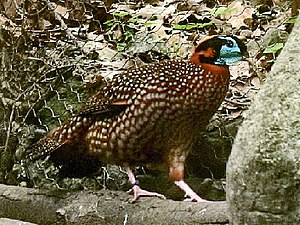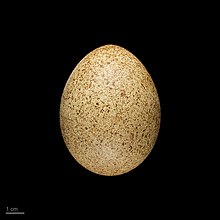Temmincktragopan
| Temmincktragopan | ||||||||||
|---|---|---|---|---|---|---|---|---|---|---|

Temmincktragopan ( Tragopan temminckii ) |
||||||||||
| Systematics | ||||||||||
|
||||||||||
| Scientific name | ||||||||||
| Tragopan temminckii | ||||||||||
| ( JE Gray , 1831) |
The Temminck's Tragopan ( Tragopan temminckii ) is a Hühnervogel art from the family of pheasant-like . It is native to Southeast Asia , where it inhabits mixed forests with bamboo at altitudes between 2500 and 3600 m. The species is relatively common in appropriate habitats and not threatened. It has the largest area of distribution of all tragopans. This borders in the east and north on that of the closely related Satyrtragopan .
description
The cock of the Temmincktragopans reaches a body length of 64 cm, of which 18-23 cm are accounted for by the relatively short tail. The wing length is between 210 and 265 mm, the weight between 980 and 1600 g. The hen is smaller and lighter with a body length of 58 cm and a tail length of 15–18 cm and a weight of 970–1100 g. The wing length is between 202 and 225 mm.
The male's beak is black with a flesh-colored tip, the iris is brown. The featherless area around the eye is blue and more extensive than that of the similar Satyrtragopan. The erectable "horns" that lie diagonally behind the eye are greenish blue, the wattles are pale blue. During courtship it can also be greatly expanded, then extends over the chest and shows a dark blue, light-spotted bib in the middle, and eight to nine scarlet fields on each side, some of which are connected to one another. The head is feathered black and wears a hood with orange stripes on the sides. On the upper sides of the neck there are orange spots that run into the lively orange of the lower neck, which merges into the dark orange-red of the body plumage on the neck and chest. On the underside this shows light gray droplet spots that get bigger towards the flanks. The back, wing coverts, rump and tail coverts show white spots framed in black. The outer upper tail-coverts are elongated, rounded and light gray with red edges. The control feathers are scribbled and cross-banded at the base on a beige background and have a wide black end band. The rooster’s feet are pink.
The predominantly brown coloration of the female varies from person to person. Sometimes it plays into the reddish brown, but never as clearly as with the hen of the satyr tragopan. This species can also be easily distinguished from the predominantly brownish-gray hens of the Cabottragopan . The entire body plumage is scrawled and spotted dark on a brown background and shows light shaft stripes or spots. The tail feathers are indistinctly dark transversely banded. The feet are pale flesh-colored.
The dress of the roosters in the first year mediates between the sexes. It is mostly similar to that of the hen, but shows the plumage typical of the rooster on the head, chest and upper back. The youth dress is similar to that of the hen.
voice
During the breeding season, an eerie, sometimes somewhat human-like, plaintive sound can be heard from the rooster, which is recited in increasing rows. At first the individual calls are a dull wo , later this changes to a loud, drawn-out and almost squawking waaaohh . This is often followed by a dull, rough series of short woah sounds.
Distribution and existence
The Southeast Asian distribution area extends from Arunachal Pradesh in northeast India eastward to northern Myanmar and northern Tonkin in Vietnam and northwards to central China . There the species occurs in Tibet , Yunnan , Sichuan , Guangxi , Guizhou , Gansu , Shaanxi , Hubei and Hunan .
The total population is estimated at over 100,000 individuals and the species is viewed by the IUCN as not endangered ( least concern ). Even if the species is described as widespread and in some places frequent, the population trend is negative due to the increasing fragmentation of habitats and, above all, the removal of undergrowth through forest grazing and the use of firewood.
The species is monotypical . The previously described Vietnamese subspecies T. t. tonkiniensis is no longer recognized.
Way of life
The Temmincktragopan populates forests with well-developed undergrowth. In China, it occurs mainly in bamboo and rhododendron stands within evergreen deciduous and mixed forests , which are mainly composed of whitebeams and snowball . The altitude distribution is around 3600 m in summer and around 2000 m in winter.
The Temmincktragopan is usually found singly or in pairs. He spends the night resting on trees, during the day he searches for food on the ground. This consists of flowers, leaves, bamboo shoots, berries and insects. In early winter mainly berries such as whitebeam and viburnum are eaten, later also grasses and ferns, which are dug up from the snow cover.
The species presumably lives monogamous , but more detailed studies on mating behavior are lacking. As with all tragopans, the "horns" in the ear area are erected and the colorful wattles - extended to several lengths - are presented at courtship. The nest stands up to 8 m high in trees. It is erected from twigs and dry leaves and lined with feathers. The clutch of 3–5 eggs speckled brown on a beige background is incubated by the female for between 26 and 28 days.
literature
- Steve Madge , Phil McGowan : Pheasants, Partridges & Grouse. Helm Identification Guides, London 2002, ISBN 0-7136-3966-0 .
- Heinz-Sigurd Raethel : Chicken birds of the world. Verlag J. Neumann-Neudamm GmbH & Co. KG, Melsungen 1988, ISBN 3-7888-0440-8 .
Web links
- Tragopan temminckii in the endangered Red List species the IUCN 2008. Posted by: BirdLife International, 2009. Accessed November 24 of 2010.
- BirdLife species factsheet , accessed November 25, 2010
- Videos, photos and sound recordings on Tragopan temminckii in the Internet Bird Collection
- Photos of Tragopan temminckii in the Oriental Bird Club image database , accessed on November 25, 2010

